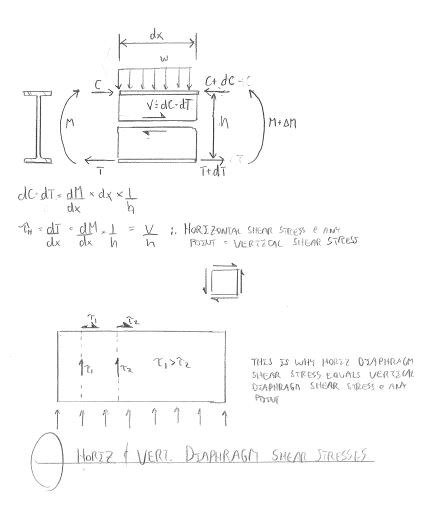structeng2
Structural
- Apr 18, 2016
- 38
Hello,
I have been scratching my head on this for a bit, so thought I would ask.
I've calculated my chord force (CF) in a flexible diaphragm. The metal deck is attached to a perimeter steel beam with puddle welds @12". What is the correct method to determine the force on the puddle welds?
In my opinion, you would follow a similar design to that of shear studs for a composite deck. v = CF / (L/2); where L = length of the chord (in this case, the full length of the diaphragm). I could then directly compare the unit shear demand, v, with my puddle weld capacity @12". Is this correct?
The confusion is coming from another engineer in my office talking about the 'zipper effect', where the highest force is at the center of the diaphragm, which could put a higher load on those welds, causing them to fail and then continue to fail the adjacent welds. I can see what he is talking about, but I don't quite understand how you would calculate that force. I am also confused with this because all the decks I've seen have evenly spaced welds - if this was true, you would have closely spaced welds at the middle with larger spacing towards the ends.
Thanks,
Peter
I have been scratching my head on this for a bit, so thought I would ask.
I've calculated my chord force (CF) in a flexible diaphragm. The metal deck is attached to a perimeter steel beam with puddle welds @12". What is the correct method to determine the force on the puddle welds?
In my opinion, you would follow a similar design to that of shear studs for a composite deck. v = CF / (L/2); where L = length of the chord (in this case, the full length of the diaphragm). I could then directly compare the unit shear demand, v, with my puddle weld capacity @12". Is this correct?
The confusion is coming from another engineer in my office talking about the 'zipper effect', where the highest force is at the center of the diaphragm, which could put a higher load on those welds, causing them to fail and then continue to fail the adjacent welds. I can see what he is talking about, but I don't quite understand how you would calculate that force. I am also confused with this because all the decks I've seen have evenly spaced welds - if this was true, you would have closely spaced welds at the middle with larger spacing towards the ends.
Thanks,
Peter

